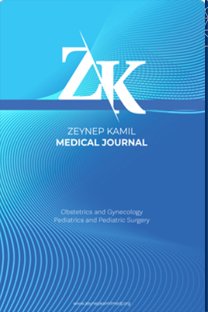External anal sphincter repair by the overlapping method in obstetric anal sphincter injury syndrome
External anal sphincter repair by the overlapping method in obstetric anal sphincter injury syndrome
___
- 1. Jha S, Parker V. Risk factors for recurrent obstetric anal sphincter injury (rOASI): A systematic review and meta-analysis. Int Urogynecol J 2016;27(6):849–57.
- 2. Meister MR, Cahill AG, Conner SN, Woolfolk CL, Lowder JL. Predicting obstetric anal sphincter injuries in a modern obstetric population. Am J Obstet Gynecol 2016;215(3):310.e1–7.
- 3. Pergialiotis V, Bellos I, Fanaki M, Vrachnis N, Doumouchtsis SK. Risk factors for severe perineal trauma during childbirth: An updated metaanalysis. Eur J Obstet Gynecol Reprod Biol 2020;247:94–100.
- 4. Durnea CM, Jaffery AE, Gauthaman N, Doumouchtsis SK. Effect of body mass index on the incidence of perineal trauma. Int J Gynaecol Obstet 2018;141(2):166–70.
- 5. Gommesen D, Nohr EA, Qvist N, Rasch V. Obstetric perineal rupturesrisk of anal incontinence among primiparous women 12 months postpartum: A prospective cohort study. Am J Obstet Gynecol 2020;222(2):165. e1–165.e11.
- 6. Zetterström J, Lopez A, Anzen B, Norman M, Holmström B, Mellgren A. Anal sphincter tears at vaginal delivery: Risk factors and clinical outcome of primary repair. Obstet Gynecol 1999;94(1):21–8.
- 7. American College of Obstetricians and Gynecologists’ Committee on Practice Bulletins. Practice bulletin No. 165: Prevention and management of obstetric lacerations at vaginal delivery. Obstet Gynecol 2016;128(1):e1–15.
- 8. Webb SS, Yates D, Manresa M, Parsons M, MacArthur C, Ismail KM. Impact of subsequent birth and delivery mode for women with previous OASIS: Systematic review and meta-analysis. Int Urogynecol J 2017;28(4):507–14.
- 9. Huser M, Janku P, Hudecek R, Zbozinkova Z, Bursa M, Unzeitig V, et al. Pelvic floor dysfunction after vaginal and cesarean delivery among singleton primiparas. Int J Gynaecol Obstet 2017;137(2):170–3.
- 10. Harvey MA, Pierce M, Alter JE, Chou Q, Diamond P, Epp A, et al. Obstetrical anal sphincter ınjuries (OASIS): Prevention, recognition, and repair. J Obstet Gynaecol Can 2015;37(12):1131–48.
- 11. Nordenstam J, Mellgren A, Altman D, Lopez A, Johansson C, Anzen B, et al. Immediate or delayed repair of obstetric anal sphincter tears-a randomised controlled trial. BJOG 2008;115(7):857–65.
- 12. Buppasiri P, Lumbiganon P, Thinkhamrop J, Thinkhamrop B. Antibiotic prophylaxis for third-and fourth-degree perineal tear during vaginal birth. Cochrane Database Syst Rev 2014;10:CD005125.
- 13. Kettle C, Dowswell T, Ismail KM. Absorbable suture materials for primary repair of episiotomy and second degree tears. Cochrane Database Syst Rev 2010;2010(6):CD000006.
- 14. Delancey JO, Toglia MR, Perucchini D. Internal and external anal sphincter anatomy as it relates to midline obstetric lacerations. Obstet Gynecol 1997;90(6):924–7.
- 15. Fernando RJ, Sultan AH, Kettle C, Thakar R. Methods of repair for obstetric anal sphincter injury. Cochrane Database Syst Rev 2013;12:CD002866.
- ISSN: 1300-7971
- Yayın Aralığı: Yılda 4 Sayı
- Yayıncı: Ali Cangül
Anxiety, quality of life, eating behaviors, and sexual life in women with polycystic ovary syndrome
Gülfem BAŞOL, Sevil KİREMİTLİ, Tunay KİREMİTLİ, Paşa ULUĞ, Kemine UZEL
Funda GÜNGÖR UĞURLUCAN, Cenk YAŞA, Sina ARMAN, Ekin İlke ŞEN, Nalan ÇAPAN, Gülşah GULA, Ayşe KARAN
An overview of anaphylaxis in children
Evaluation of blood pressures measured at the clinic and during exercise test in children
Nurdan EROL, Çiğdem EROL, İlke AKTAŞ
Seroprevalence of Varicella-Zoster in the first trimester of pregnancy
Fırat TÜLEK, Bülent Berker, Alper KAHRAMAN
Effects of topical Povidone-iodine on thyroid function in surgical newborns
Ayşenur CELAYİR, Sırma Mine TİLEV, Burcu ARI, Tuba ERDEM
Ectopic pelvic kidney: Prenatal diagnosis and management
Gürcan TÜRKYILMAZ, Bilal ÇETİN
External anal sphincter repair by the overlapping method in obstetric anal sphincter injury syndrome
